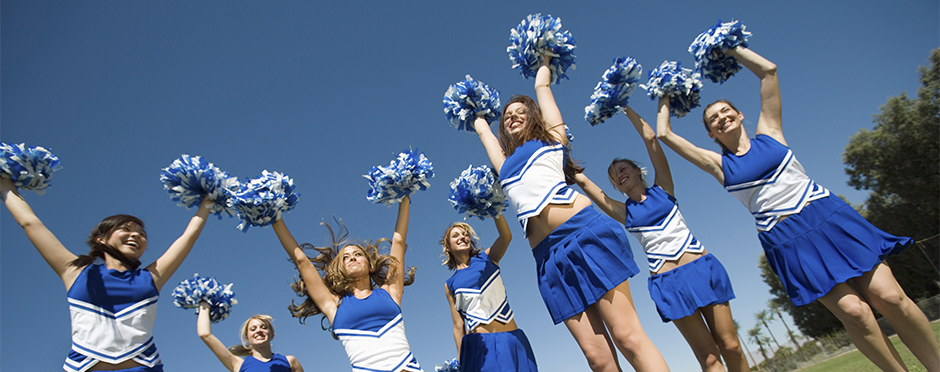
Is Back Pain Common in Cheerleading?
1 CommentCheerleading is a common sport in high schools and universities but it is also popular as a competitive all-star sport. These all-star teams are often a variety of ages, they can be co-ed, and the teams practice multiple days per week for competitions. Due to the nature of the sport, cheerleaders are more susceptible to certain injuries, including low back pain.
Back pain in cheerleaders is often the result of repetitive movement rather than a one-time traumatic event. Overuse injuries in the back are due to repeated extension required by back bends, tumbling and standing for long periods of time. Many cheerleaders exhibit similar patterns of muscle imbalances including tight hip flexors, weak lower core muscles, weak glute muscles and excessively flexible hamstring muscles. These imbalances can cause the athlete to stand in an extended low back posture (sway back) throughout their daily tasks. This posture can place increased strain on the muscles, ligaments and joints of the spine.
Cheerleading has two main positions – flyers and bases. The flyers are the athletes who go up in the air for stunts whereas the bases are the athletes helping to hold them up, spotting and catching the flyers after a toss. Bases are at increased risk of injury compared to flyers.1 Bases are also at an increased risk for the extended low back posture when they are raising their teammate over their head. Both male and female cheerleaders can be affected by low back pain.
Types of Low Back Injuries
- Muscle Strain: A strain is an injury to the muscle. The spine has many muscles surrounding it. A strain can occur when a cheerleader moves suddenly and forcefully, causing a fast stretch in the tendon or muscle that can result in spasm. Generally there is pain, possibly swelling, and difficulty moving afterward. The treatment of a strain is rest, ice/heat and gentle stretching initially. Physical therapy can help cheerleaders after a low back strain by helping to strengthen their core muscles and identifying weaknesses or muscle tightness that may affect them during their sport activities.
- Spondylolysis: Spondylolysis is a fracture of the spine. It is common in athletes who do a lot of jumping, tumbling and back bending type activities. Symptoms include low back pain that is worse with bending backward, such as back walkovers or back handsprings. Cheerleaders with back pain that lasts longer than two weeks should see a doctor to determine if x-rays are necessary. X-rays are often the way to diagnose this type of fracture. Treatment for spondylolysis includes rest and avoiding back extension activities. Physical therapy can help to strengthen the abdominal and back muscles after spondylolysis.
- SIJ Dysfunction: The sacroiliac joints are the junction of the spine with the lower extremities. Cheerleaders may experience pain in the low back where the hips meet the tailbone and pain may be worse when standing on one leg. SIJ dysfunction can occur after repetitive landing on one leg, landing a tumbling pass short, or a fall. Treatment of SIJ dysfunction includes physical therapy to correct muscle and flexibility imbalances as well as core strengthening.
How to Prevent Low Back Pain in Cheerleaders
As mentioned above, cheerleaders tend to have weakness in their core muscles and glute muscles as well as tightness in their hip flexors. This pattern needs to be addressed to help protect the low back. An important component of preventing low back pain is postural awareness; cheerleaders need to be aware of their poor posture throughout the day and try to prevent a sway back posture by focusing on a neutral spine. A strengthening and conditioning program for cheerleaders should focus on core and hip strengthening.
A core strengthening program centering on a neutral spine is vital for cheerleaders. It is important that cheerleaders use the transverse abdominis muscle to prevent the “sway back” position. Begin strengthening by lying on your back to help cue when there is a neutral spine, as there will not be space between the back and the floor. Reminder that breathing is important during all core strengthening exercises. Once this neutral back is achieved in supine (lying face upward), exercises can progress to quadruped, plank, sitting on an exercise ball, and standing.
Although low back pain is common, posture and strengthening can help decrease the rate of low back pain in cheerleaders. If you have low back pain, visit your closest Athletico for a free assessment.
The Athletico blog is an educational resource written by Athletico employees. Athletico bloggers are licensed professionals who abide by the code of ethics outlined by their respective professional associations. The content published in blog posts represents the opinion of the individual author based on their expertise and experience. The content provided in this blog is for informational purposes only, does not constitute medical advice and should not be relied on for making personal health decisions.
References
1. Bagnulo, Angela. “Cheerleading injuries: A narrative review of the literature.” The Journal of the Canadian Chiropractic Association vol. 56,4 (2012): 292-8.

1 Comment
Stella Mary
Good post to learn about what causes back pain in cheerleaders and how they can protect themselves from this unwanted pain. Thank you for sharing the post.